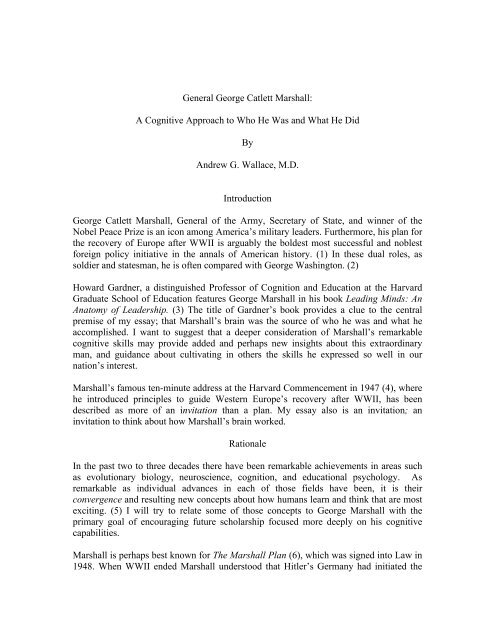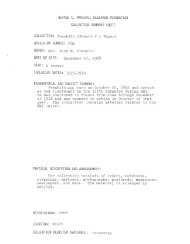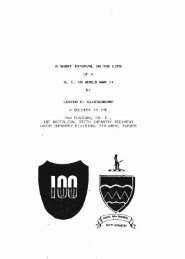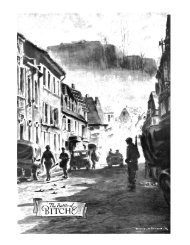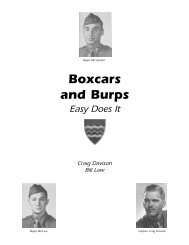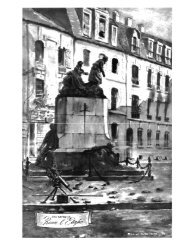General George Catlett Marshall - The George C. Marshall Foundation
General George Catlett Marshall - The George C. Marshall Foundation
General George Catlett Marshall - The George C. Marshall Foundation
You also want an ePaper? Increase the reach of your titles
YUMPU automatically turns print PDFs into web optimized ePapers that Google loves.
<strong>General</strong> <strong>George</strong> <strong>Catlett</strong> <strong>Marshall</strong>:<br />
A Cognitive Approach to Who He Was and What He Did<br />
By<br />
Andrew G. Wallace, M.D.<br />
Introduction<br />
<strong>George</strong> <strong>Catlett</strong> <strong>Marshall</strong>, <strong>General</strong> of the Army, Secretary of State, and winner of the<br />
Nobel Peace Prize is an icon among America’s military leaders. Furthermore, his plan for<br />
the recovery of Europe after WWII is arguably the boldest most successful and noblest<br />
foreign policy initiative in the annals of American history. (1) In these dual roles, as<br />
soldier and statesman, he is often compared with <strong>George</strong> Washington. (2)<br />
Howard Gardner, a distinguished Professor of Cognition and Education at the Harvard<br />
Graduate School of Education features <strong>George</strong> <strong>Marshall</strong> in his book Leading Minds: An<br />
Anatomy of Leadership. (3) <strong>The</strong> title of Gardner’s book provides a clue to the central<br />
premise of my essay; that <strong>Marshall</strong>’s brain was the source of who he was and what he<br />
accomplished. I want to suggest that a deeper consideration of <strong>Marshall</strong>’s remarkable<br />
cognitive skills may provide added and perhaps new insights about this extraordinary<br />
man, and guidance about cultivating in others the skills he expressed so well in our<br />
nation’s interest.<br />
<strong>Marshall</strong>’s famous ten-minute address at the Harvard Commencement in 1947 (4), where<br />
he introduced principles to guide Western Europe’s recovery after WWII, has been<br />
described as more of an invitation than a plan. My essay also is an invitation; an<br />
invitation to think about how <strong>Marshall</strong>’s brain worked.<br />
Rationale<br />
In the past two to three decades there have been remarkable achievements in areas such<br />
as evolutionary biology, neuroscience, cognition, and educational psychology. As<br />
remarkable as individual advances in each of those fields have been, it is their<br />
convergence and resulting new concepts about how humans learn and think that are most<br />
exciting. (5) I will try to relate some of those concepts to <strong>George</strong> <strong>Marshall</strong> with the<br />
primary goal of encouraging future scholarship focused more deeply on his cognitive<br />
capabilities.<br />
<strong>Marshall</strong> is perhaps best known for <strong>The</strong> <strong>Marshall</strong> Plan (6), which was signed into Law in<br />
1948. When WWII ended <strong>Marshall</strong> understood that Hitler’s Germany had initiated the
war, killed millions of people, perpetrated the Holocaust, and destroyed much of<br />
industrial capacity throughout Europe and Western Russia. Importantly, <strong>Marshall</strong> also<br />
understood that lasting peace depended upon restoring confidence and hope among all<br />
people of Europe and upon reestablishing the fabric of Europe’s economy as a whole. In<br />
its final form <strong>The</strong> <strong>Marshall</strong> Plan contributed directly to Europe’s economic recovery, to<br />
restoring morale, and to the containment of communism. Indirectly, through cooperation<br />
that the Plan was intended to foster, it also laid the groundwork for the formation of<br />
NATO, the European Union, and even a common currency, the EURO. In short, <strong>The</strong><br />
<strong>Marshall</strong> Plan changed the culture of Europe for the next sixty years”. It was a dramatic<br />
example of big picture thinking and ethical leadership at the highest level.<br />
During WWII <strong>Marshall</strong> was the U.S. Army Chief of Staff and among his U.S.<br />
counterparts he was “first among equals.” More than any other individual <strong>Marshall</strong><br />
understood the strategic need for balanced strength among our forces on land, air and sea.<br />
With an urgent need for cooperation among the Allies, <strong>Marshall</strong> proposed and Roosevelt<br />
and Churchill agreed to merge their respective service chiefs to form a “Combined<br />
Committee of Chiefs of Staff” for planning and coordinating the war effort. <strong>Marshall</strong><br />
further convinced Roosevelt and Churchill of the need for single “Supreme<br />
Commanders” in each of the <strong>The</strong>aters of War. Many have described this series of<br />
organizational changes as <strong>Marshall</strong>’s ability to achieve the impossible. He was capable of<br />
thinking about, coordinating and leading a multi-national worldwide war effort – not only<br />
because of his military expertise, but also his ability to think strategically and to organize<br />
on a grand scale. (7)<br />
<strong>Marshall</strong> had just become Chief of Staff of the U.S. Army when Germany invaded<br />
Poland in 1939. He believed that Britain could not defeat Germany alone and recalling<br />
America’s lack of preparedness at the beginning of WWI, he convinced Roosevelt (and<br />
Congress with an isolationist point of view) to enlarge our Army from 175,000 men to<br />
1,400,000 by 1941. It later grew to 8 million. He did that by speaking candidly and by<br />
supporting the Selective Training and Service Act of 1940, the first peacetime Draft in<br />
America’s history. His pre-war efforts were not limited to the Draft; they also included<br />
creation of training sites; identification of new leaders; and mobilizing our manufacturing<br />
capacity to produce weapons, ammunition, airplanes and ships. Each step was<br />
accompanied by major budgetary implications requiring congressional approval. Sam<br />
Rayburn, Speaker of the House during those years, said this of <strong>Marshall</strong>: "Of all the men<br />
who ever testified before any committee on which I served, there is no one of them who<br />
has the influence ... <strong>General</strong> <strong>Marshall</strong> has." <strong>The</strong> reason was simple, he continued, "It is<br />
because when he takes the witness stand we forget whether we are Republicans or<br />
Democrats. We remember that we are all Americans, and in the presence of a man who is<br />
telling the truth”. (8) In his 1990 book On Leadership, John W. Gardner described<br />
<strong>Marshall</strong> as having “a limitless ability to inspire trust”. (9)<br />
Much of what has been written about <strong>George</strong> <strong>Marshall</strong> appropriately treats these qualities<br />
of expertise, strategic thinking, seeing the picture whole, interpersonal communication,<br />
and trust as “attributes” of his leadership style. I want to suggest that they were cognitive<br />
skills reflecting how <strong>Marshall</strong>’s brain developed. Furthermore, these skills were<br />
2
expressed by him and appreciated by others earlier in <strong>Marshall</strong>’s life and substantially<br />
before WWII. Let me offer just two brief examples of the earlier evidence of these<br />
qualities:<br />
First, as a student at <strong>The</strong> Virginia Military Institute (Class of 1901) <strong>George</strong> <strong>Marshall</strong> was<br />
an average student, but as a cadet he was noted for his “selflessness, problem-solving<br />
skills, and particularly for his integrity”. Each year he was selected cadet-leader of his<br />
class and in his senior year he was chosen to be the Institute’s “First Cadet.” (10)<br />
Second, in presenting the Nobel Peace Prize to <strong>Marshall</strong> in 1953, Carl Hambro said this:<br />
“Typical of the high esteem in which he (<strong>Marshall</strong>) was held is what happened in 1916 ...<br />
He took over the training program at a camp in Utah. When the camp closed the<br />
commanding officer was required to make a report on the officers under his command.”<br />
One question was “Would you desire to have him under your immediate command in<br />
peace and in war.” <strong>The</strong> Colonel wrote in reply, concerning <strong>Marshall</strong>, “Yes, but I would<br />
prefer to serve under his command ... in my judgment there are not five officers in the<br />
Army so well qualified as he to command a division in the field.” (11) At that time<br />
<strong>Marshall</strong> was twenty-six years old and he was still a first lieutenant.<br />
How a human brain develops and works (5) (12) (13)<br />
I want to digress at this point from <strong>George</strong> <strong>Marshall</strong> and certain of his attributes to<br />
summarize several important concepts about how the human brain works. Some of these<br />
concepts are relatively new, yet they are an essential basis for examining <strong>George</strong><br />
<strong>Marshall</strong> from the perspective of cognitive skills.<br />
While all that went before in our evolutionary history is significant, there has been a<br />
nearly thousand-fold increase of the mammalian brain’s cortical surface area during the<br />
past one million years. Most of that change within the human lineage has been in the<br />
prefrontal, parietal and temporal areas; regions of the brain we now know to be critically<br />
related to learning, memory, language and thinking.<br />
Cortical neurons responsible for these functions do not originate in the cortex per se;<br />
rather they form in embryonic vesicles and then migrate to cortical locations along<br />
scaffolds created by radially oriented supporting fibers. (14) (15) Once positioned at their<br />
ultimate destination, cortical neurons take on functional identity; e.g. sensory or motor or<br />
inter-neurons, and only then do they send out axons to connect with other cells. This<br />
latter process is not random. Rather, it too is accomplished in a sequence of intermediate<br />
steps following molecular signals.<br />
When axons reach a target cell a communication mechanism is established through the<br />
formation of synapses. In these connections the pre-synaptic axon expresses a cluster of<br />
vesicles that synthesize and release a diffusible neurotransmitter. <strong>The</strong> post-synaptic<br />
element (a dendrite of another neuron) contains a cluster of receptors for the<br />
neurotransmitter. <strong>The</strong> action of the transmitter on the receptor is responsible for<br />
activating the target cell, i.e. communication.<br />
3
<strong>The</strong> picture I have painted so far is one of a brain built over time in a programmed<br />
manner by processes largely controlled by our gene pool and principally expressed as<br />
predictable outcomes within and to some extent even across species. However, to<br />
appreciate the complexity of the human brain we also must consider that there are<br />
approximately ten billion neurons in the human cerebral cortex and the average cortical<br />
neuron makes up to ten thousand synaptic connections with other neurons.<br />
Gerald Edelman has been the principal contributor to a “population-based theory” of<br />
brain development that he calls Neuronal Group Selection. (16) According to his theory<br />
the human brain can be viewed as a product of our gene pool, but only up to a point.<br />
Development and organization of the brain also are influenced importantly by "epigenetic<br />
phenomena”. For example, the formation of specific neural networks is not pre-specified<br />
by a genetic blueprint. Rather, networks arise in part because of regional competition<br />
among neurons for growth factors, even before birth.<br />
At yet another level, and largely after birth, synaptic connections within and between<br />
neuronal groups are strengthened or weakened by use. Indeed, entire neuronal groups<br />
disappear and still others become connected as a result of perceptual experiences (or their<br />
lack) with the outside world. Connected neuronal groups form three-dimensional maps,<br />
which are key to understanding memory and the ability of the brain to categorize new<br />
perceptual inputs. Connected maps, in turn, underlie the well-known cognitive<br />
characteristic of associative memory. (17)<br />
Based on these epigenetic features of development there is every reason to believe that no<br />
two human brains (even those of monozygotic twins) are identical even at the time of<br />
birth. Furthermore, we are each born with neuronal connections that are maintained only<br />
if confirmed through use, and additional connections are formed after birth and even into<br />
adult life. <strong>The</strong>se processes of subtraction and addition may produce relatively little net<br />
change in overall synaptic density. However the turnover of synapses based on<br />
experiences with the environment is very considerable. This adds to the view that every<br />
mature brain is functionally unique.<br />
Individual processes, which relate to our cognitive functions, reside primarily in one or<br />
more neuronal groups. Despite these localized processing elements all complex cognitive<br />
functions involve more than one connected cortical area. A good example is language:<br />
words that are heard are processed in one area; words that are seen in another area; and<br />
words that are thought of but not heard or seen in still another. Even for words heard or<br />
seen the recognition of an individual word occurs in one area of the brain, but its meaning<br />
within syntactical structures is processed elsewhere. As a result, a localized brain region<br />
is not wholly responsible for any complex cognitive function, but rather with elemental<br />
processing-components of that function within the context of a larger system.<br />
Our cognitive functions include at a minimum perception, attention, learning, memory,<br />
language and other symbolic representations such as numbers, social cognition (e.g.<br />
understanding ones self and others), and executive processing (e.g. reasoning, decision-<br />
4
making, and problem solving). (18)<br />
“Learning is the word used to represent the process by which we perceive and acquire<br />
information about the world through our senses, while memory is the word used to<br />
represent the processes by which we store that information in a form that can be retrieved<br />
at a later time. Memories are formed in stages. <strong>The</strong> initial stage is called encoding and<br />
includes a brief but adequate time period during which attention is focused on a sensory<br />
input that activates an appropriate network of neurons. Repeated activation within a short<br />
time frame leads to facilitation of synaptic transmission in the network, which persists for<br />
seconds or minutes after the input is removed. This brief period of facilitated<br />
transmission within existing networks is called short-term memory.<br />
Conversion of short-term to long-term memories is referred to as consolidation. Longterm<br />
memories last for hours, days, years, or even a lifetime. At a functional level<br />
consolidation represents a long-lasting increase in either the strength or number of<br />
synapses within a network. At a molecular level consolidation involves gene expression,<br />
new protein synthesis, and the turnover of dendritic spines. Thus, consolidation causes a<br />
long-lasting structural change in the brain.<br />
In research we are familiar with a distinction between data and information. <strong>The</strong> latter<br />
generally reflects both the conclusions drawn from data and the meaning of those<br />
conclusions in some broader context. It is useful in thinking about how the brain works<br />
to draw a parallel distinction between long-term memories and knowledge. Knowledge<br />
depends upon several individual memories that are accurate and have been categorized as<br />
to importance. Knowledge also depends on associative-memory, i.e. maps of memories<br />
that are not only accurate, but also connected and related. Constructivism is a theory<br />
which views knowledge as actively built over time by the learner. (19) Put another way,<br />
knowledge is built from what one already knows: then as a consequence of either adding<br />
or subtracting or correcting elements essential to understanding the resulting knowledge<br />
is modified. 1<br />
<strong>The</strong> most important messages from these considerations are three; first, knowledge and<br />
by extrapolation expertise are higher order cognitive capacities that depend upon<br />
associative neural connections related to memory, second the learner builds these neural<br />
connections through structural changes to the brain at a molecular level, and third<br />
building these connections is an active process.<br />
Of special interest to my goals for this essay is the concept of Expertise. Experts have<br />
acquired extensive knowledge in their domain, but what distinguishes them most from<br />
novices is; their knowledge is organized along core concepts or principles, they have the<br />
ability to look at new situations and see features and patterns not evident to the novice,<br />
and despite holding a vast repertoire of knowledge in their domain that knowledge is<br />
<br />
1 <strong>The</strong> three paragraphs above are either direct quotes or paraphrases from an unpublished<br />
essay I wrote in 2007, and they also appeared in a chapter I wrote; Passing on the Stead<br />
Legacy for a book called Learning to Learn (20) to be published in 2010. <br />
5
conditioned so it can be selected, recalled, and applied in a seemingly effortless manner.<br />
Areas of expertise in which these characteristics have been studied and are especially<br />
well documented included: chess, electronics, music, math, computer programming,<br />
physics, history, and teaching. (21)<br />
Human cognitive functions also depend upon more than would be predicted from either<br />
individual or even the sum of discrete competences. <strong>The</strong>se “higher-order” functions<br />
include the ability to initiate (or inhibit) processes such as reasoning, planning, decisionmaking<br />
and problem solving, and to shift between tasks. <strong>The</strong> selection and weighing of<br />
inputs to these latter processes adhere to previously learned rules that guide goal-directed<br />
actions. Collectively, these functions are referred to as “executive processes”. <strong>The</strong><br />
neural networks responsible for executive processing reside principally in the frontal<br />
cortex of the brain, but also in the cingulate cortex. (22) (23)<br />
Finally, in 1983 Howard Gardner challenged the long and widely-held view that<br />
intelligence is a general cognitive capacity; possessed in varying degrees by everyone,<br />
measurable by a pencil and paper test, and reducible to a single number – your “I.Q.” In<br />
his Book: Frames of Mind (24) Gardner introduced a new view referred to as “Multiple<br />
Intelligences.” Gardner’s theory starts with a premise: “an intelligence is a cognitive<br />
competence that results either in the creation of a novel product or the solution of a<br />
problem, and further … this product/solution is valued by the culture in which the<br />
competence is expressed.” He went on to suggest several criteria that could be used to<br />
assess whether a candidate-ability should be regarded as an intelligence, or not. His first<br />
criterion was that the competence could be either selectively destroyed or compromised<br />
as a result of brain injury. Closely related to this criterion was that the competence may<br />
be expressed in a precocious manner in otherwise normal children, or it may be spared in<br />
the presence of highly retarded performance in most other intellectual domains (i.e. the<br />
savant syndrome). Lastly, the competence can be developed to varying levels with<br />
training and it may be expressed at exceedingly high levels in a few individuals.<br />
According to Gardner these independent neural-based intelligences include at a<br />
minimum: linguistic, musical, logical-mathematical, spatial, bodily-kinesthetic, and<br />
personal intelligences (the latter embracing both a sense of self and separately a sense of<br />
others). A few of the most notable features of Gardner’s thoughts are these. First, we all<br />
possess these intellectual competences and perhaps more. Second, as a result of<br />
interactions between heredity and environment during brain development no two<br />
individuals express these competences in exactly the same proportion. Third, we each<br />
have a unique profile of intelligences and a unique potential for their individual<br />
development.<br />
Back to <strong>George</strong> <strong>Marshall</strong><br />
My goal in this essay is to invite readers to view <strong>George</strong> <strong>Catlett</strong> <strong>Marshall</strong> through a<br />
particular lens, a view that postulates that who he was and how he did what he did were<br />
reflections of how his brain worked. It seems to me that <strong>George</strong> <strong>Marshall</strong> possessed a<br />
remarkable portfolio of neural-based cognitive abilities. I am not suggesting that he was<br />
6
orn with those abilities, although in the sense of Howard Gardner’s Multiple<br />
Intelligences, he may have been born with an unusual potential for the development of at<br />
least some of them.<br />
In my research on <strong>Marshall</strong> I have tried to look at what has been written about him, to<br />
search for clues to specific cognitive skills, when and how they developed, and how he<br />
used them either individually or together to achieve purposes of such great importance.<br />
However, it is vital to emphasize that the relationships I will suggest, between cognitive<br />
skills and <strong>Marshall</strong>’s performance, should be viewed as “hypotheses” potentially worth<br />
testing rather than as conclusions. I am neither an expert on <strong>George</strong> <strong>Marshall</strong> nor a<br />
cognitive neuroscientist, but as an outsider I have studied and been intrigued by both and<br />
their possible connection.<br />
Let me began with a general comment after reading the on-line version of the Pogue –<br />
Interviews and Reminiscences with <strong>George</strong> <strong>Marshall</strong>. (25) <strong>The</strong>se consist of five hundred<br />
and seventy six pages of transcripts, based on nineteen taped interviews with <strong>Marshall</strong>,<br />
conducted during 1956 and 1957, by and for Forrest C. Pogue. <strong>The</strong> subjects covered<br />
span <strong>George</strong> <strong>Marshall</strong>’s life from childhood in the 1880s to <strong>The</strong> <strong>Marshall</strong> Plan, which<br />
officially ended in 1952.<br />
My overarching impression from the transcript of Pogue’s interviews is that <strong>George</strong><br />
<strong>Marshall</strong> had an outstanding, and possibly an extraordinary long-term memory. We<br />
know that Pogue sometimes gave <strong>Marshall</strong> a list of questions in advance, but there is<br />
little evidence that <strong>Marshall</strong> had access to or used documents from the past to prepare for<br />
the interviews. Rather, he relied principally on memory. Here is a very brief example of<br />
his memory at work. When asked by Pogue for some general comments about his early<br />
life, <strong>Marshall</strong> began by saying this:<br />
“To begin with, my first very clear recollection is going out to our barn in<br />
which we kept a horse and a cow. It was rather large for a place in town and<br />
when originally built had been on the edge of town. My recollection goes<br />
back to climbing up the ladder, which was fastened to the side of the barn, in<br />
an effort to get to the haymow - the first time I had ever tried this. My brother<br />
had gone ahead of me and had disappeared in the haymow. And as I climbed<br />
up the ladder, being very cautious and a little frightened, I came to a<br />
windowless opening, which I could look out of between the rungs of the<br />
ladder. In a sense, it seemed to me - my recollection is - that this was my first<br />
look at the world. A creek ran through our place, and my line of vision went<br />
down the line of the creek. I saw some little distance below me some highly<br />
colored ducks swimming about, which of course attracted my eye<br />
immediately. <strong>The</strong>re was a dog or two along the bank. <strong>The</strong>re were chickens<br />
wandering about. All of it fascinated me and it seemed a whole world exposed<br />
in an instant to my eye.” (26)<br />
<strong>The</strong> experience described above must have occurred at least sixty years prior to being<br />
recalled by <strong>Marshall</strong> at the interview. Note the level of detail, the feeling, the color and<br />
7
movement, and the succinct capture of meaning “... it seemed a whole world exposed in<br />
an instant to my eye”. Almost every page of the Pogue Interviews contains <strong>Marshall</strong>’s<br />
recollections at this level of detail.<br />
Nearly everyone who worked with <strong>George</strong> <strong>Marshall</strong>, or who has written or spoken about<br />
him, attests to his exceptional memory. He had trouble remembering names, but he could<br />
remember something about practically everyone he met. At press conferences he would<br />
begin by asking up to thirty reporters what questions they wanted him to address. <strong>The</strong>n,<br />
after hearing all the questions he would speak for perhaps thirty minutes answering each<br />
question and usually making eye contact with the reporter who had earlier asked the<br />
question. When he testified before congress over one hundred times, he prepared ahead<br />
of time, but he typically spoke without notes. (27) Eric Severeid, the CBS news<br />
correspondent, summarized <strong>Marshall</strong> this way: “a ... man ... [with] the memory of an<br />
unnatural genius”. (28)<br />
Carl Hambro, in presenting the 1953 Nobel Peace Prize to <strong>George</strong> <strong>Marshall</strong> said: “<strong>The</strong><br />
first of two things that stand out for those trying to follow <strong>Marshall</strong>’s development was<br />
his insatiable desire to learn, to know, and to understand...” (29) This feature of<br />
<strong>Marshall</strong>’s cognitive development was not particularly evident in his youth, or even when<br />
he was a student at VMI. He was an average student at best. <strong>Marshall</strong> received his<br />
commission as a second lieutenant in 1902. In 1906 he qualified to attend the Infantry<br />
and Calvary School at Fort Leavenworth, which offered what amounted to the army’s<br />
first post-graduate program in the theory and practice of war. <strong>Marshall</strong> thrived on this<br />
experience and he finished first in a class of highly motivated and mostly older students.<br />
<strong>Marshall</strong> said later: “this is where I learned how to learn.” (30)<br />
One of <strong>Marshall</strong>’s skills was his ability to learn from experience. From 1910 to 1916 he<br />
had a series of assignments, mostly in the U.S., and then in 1917 he joined the American<br />
Expeditionary Force (AEF) in France during WWI. He held important staff roles,<br />
including one at AEF <strong>General</strong> Headquarters where he planned major campaigns with the<br />
English and French and served under <strong>General</strong> Pershing. After WWI he served for five<br />
years as aide-de-camp to <strong>General</strong> Pershing when the latter was the Army’s Chief of Staff<br />
in Washington, DC. In that role <strong>Marshall</strong> acquired considerable experience in dealing<br />
with congress, the President, and foreign leaders. Pershing became not only <strong>Marshall</strong>’s<br />
role model, but he also provided in-depth education in civilian-military interactions.<br />
Subsequently, <strong>Marshall</strong> taught at the Army War College and held a series of assistant<br />
commandant and command positions, which included the Civilian Conservation Corps<br />
and the National Guard. In these roles he acquired deep respect for and skill in<br />
promoting the morale and motivation of those who served under him, including civilians.<br />
From 1938 to 1939 he served as assistant chief of staff, then as deputy chief of staff, and<br />
then later as Chief of Staff, U.S. Army, War Department, Washington, DC.<br />
All of these experiences contributed to his growing knowledge and to his extraordinary<br />
gifts as a leader. However, I think that key to understanding this growth and his<br />
expanding knowledge was that he approached each and every experience as a learning<br />
opportunity. What he learned shaped his brain and how it worked in a lasting way. <strong>The</strong><br />
8
ability to learn was one of his distinctive cognitive skills.<br />
My second impression from reading the Pogue Interviews and Reminiscences is that<br />
<strong>George</strong> <strong>Marshall</strong> was broadly informed by his extensive reading. He grew up in a family<br />
where reading was a part of most days and always enjoyed. For example, “... the <strong>General</strong><br />
recalled that his father read very well. <strong>The</strong> family assembled several nights a week, he<br />
(the father) read to them, and these were serious books: Sant’ Zlario and Don Orsino by<br />
F. Marion Crawford, many of the books of James Fenimore Cooper, Arthur Conan<br />
Doyle’s <strong>The</strong> Refugees, Eugene Sue’s <strong>The</strong> Wandering Jew, and William Prescott’s<br />
Conquest of Mexico. “Even in older years the <strong>General</strong> remembered some of the tales,<br />
particularly those that concerned Indians, so vividly he could hardly forbear to retell them<br />
and recapture the excitement of those evenings long ago.” <strong>Marshall</strong> went on to say: “My<br />
favorite books were of a historical nature. I don’t mean just histories, but books that bore<br />
on history [for example] the G. A. Henty books. I read all of them, I think.” [<strong>The</strong>re were<br />
over 100]. (31).<br />
Pogue later asked, “What were the books you read while at VMI?” <strong>Marshall</strong> responded:<br />
“Of the books that I read at that time, it was pretty much anything I could get my hands<br />
on, particularly the last year and a half. I didn’t discover until then that my roommate<br />
Nicholson - he and his brothers were orphans and they owned the Times-Picayune<br />
[newspaper] - made a casual remark one day that they got all these books to review and<br />
they sold them for five cents apiece. So we immediately got him to contact a friend of his<br />
on the paper and ... the friend would send us a barrel of books at a time. ... I was a rapid<br />
reader and Peyton was a rapid reader. Peyton and I just read through the barrel. ... I [also]<br />
read a little in the library. 1 remember coming across for the first time Rudyard Kipling<br />
and I read every book they had by Kipling.” (32)<br />
As an adult <strong>Marshall</strong> read almost every night before going to bed, mostly for pleasure.<br />
He read widely, but mostly history. He read Thucydides on the Peloponnesian War,<br />
about the Roman conquests, about Cicero, Napoleon, and the Civil and Spanish<br />
American Wars. He read rapidly, but he also had a remarkable capacity to digest what he<br />
read and to capture lessons he could remember and use on future occasions.<br />
Here is one example from his 1953 speech accepting <strong>The</strong> Nobel Prize, titled <strong>The</strong><br />
Essentials of Peace (33):<br />
“I will try to phrase my views or suggestions in the simplest possible terms<br />
though I lack the magic and artistry of that great orator whom the Nobel<br />
Committee in Stockholm so appropriately honored yesterday. In making my<br />
statement I will assume your familiarity with the discussions and efforts of the<br />
past eight years and also with something of the conditions which have governed<br />
each long continued peace in world history. I would like to make special mention<br />
of the years of the Pax Romana, which endured through almost all of the first two<br />
centuries of the Christian era. I do so because of a personal incident, which made<br />
a profound impression on me in the spring of 1919. Arriving late at night in<br />
Chaumont, the American Headquarters in France, I sought shelter for the night in<br />
9
the house of a group of friends. I found they were temporarily absent; so I<br />
selected an unoccupied room and looked about for a book to read as I waited for<br />
sleep to come. <strong>The</strong> books available were mostly in French or German. Since I was<br />
unable to read them with facility, I looked further and finally found an English<br />
textbook on the history of Gaul. Casting about for an interesting portion, I landed<br />
on a description of the famous Roman Peace. Included in this description was a<br />
statement of the dispositions of the Roman troops during this prolonged period, a<br />
legion at Cologne, another at Coblenz, a third at Mayence, and the reserve at<br />
Trier. Now those happened to be the identical dispositions of our Allied Forces<br />
some eighteen hundred years later, with the Peace Commission sitting in Paris<br />
and evolving the policy of the League of Nations.”<br />
This is <strong>George</strong> <strong>Marshall</strong> at his best, remembering something he had read thirty-four years<br />
earlier and associating that memory with the effort to create a League of Nations at the<br />
end of WWI, and then with his rationale for <strong>The</strong> <strong>Marshall</strong> Plan after WWII.<br />
<strong>Marshall</strong>’s experiences and his reading both contributed to his vast knowledge. But his<br />
knowledge also was organized around principles and themes. L. J. Halle said of <strong>Marshall</strong>:<br />
“He could distinguish what was important from what was not important.” (34). In the<br />
book Thinking in Time (35) Neustadt and May observed that <strong>Marshall</strong> developed a habit<br />
of “seeing time as a stream,” that is applying a consciousness of past problems, ideas, and<br />
solutions to the present rather than seeing every current problem in isolation. <strong>Marshall</strong>’s<br />
knowledge was organized and could be expressed and applied in the manner cognitive<br />
scientists refer to as expertise. (36).<br />
<strong>Marshall</strong> developed over time a special way of interacting and communicating with<br />
others. <strong>The</strong>se abilities highlight another of his cognitive skills, what some have referred<br />
to as social cognition (37) or what Howard Gardner called personal intelligence. (38).<br />
Many sources could be used to document this highly effective element of <strong>Marshall</strong>’s<br />
cognitive repertoire. I have chosen a few excerpts from H. Merrill Pasco’s <strong>Marshall</strong><br />
Lecture delivered in 1996 (39) to illustrate the point. Pasco handled <strong>Marshall</strong>’s personal<br />
correspondence, summaries of staff studies, schedule, and served daily as liaison to the<br />
Secretary of War and to the White House from 1941-1945. So he knew <strong>Marshall</strong> well.<br />
Here is <strong>Marshall</strong> in Pasco’s words:<br />
“His public persona was the result of overpowering self discipline which he<br />
cultivated purposefully to suit his style of leadership. <strong>The</strong> aura he was able to<br />
create intentionally of an impersonal, wholly objective and serious public servant<br />
who would tolerate no interference with the performance of his public duties,<br />
coupled with his unshakable integrity and profound intellect, enabled him to<br />
achieve a position of respect with the media and the Congress as well as with<br />
President Roosevelt and Secretary Stimson that no other public figure even<br />
approached.”<br />
Note that Pasco describes <strong>Marshall</strong>’s public persona as “cultivated purposefully” and<br />
10
“intentionally” to achieve respect with the media and those he served under. Yet Pasco<br />
goes on to say:<br />
“ ... This courtly, austere officer in public with the icy blue eyes, formal public<br />
manners and serious countenance differed 180 [degrees] from the warm, relaxed,<br />
compassionate, considerate man of simple tastes in private life.<br />
... My first impressions of <strong>General</strong> <strong>Marshall</strong> ... were the overwhelming power and<br />
force of his presence ... At the same time the <strong>General</strong> constantly had great<br />
concern for the feelings of others, including his immediate staff ... <strong>Marshall</strong>'s<br />
humanity and consideration for others was manifest in the intense concern he had<br />
for the welfare, both mental and physical, of the soldiers in the Army.<br />
... One of the most vivid impressions I have of <strong>General</strong> <strong>Marshall</strong> was his quiet<br />
confidence in his own ability to handle people and arrive at sound judgments ...<br />
<strong>The</strong>re was no doubt that he was quite aware of his ability to run the Army and the<br />
war better than anyone else.”<br />
Pasco then quotes this description of <strong>General</strong> <strong>Marshall</strong> by Ambassador Bruce:<br />
“<strong>Marshall</strong> radiated a sort of majesty about his selflessness. He was a wonderful<br />
combination of strength, understanding, and almost gentleness. He always spoke<br />
to the purpose. Although he never thundered like a prophet, you found yourself<br />
clinging to every syllable he utters, afraid of missing any of it. ... His moral<br />
character was almost physically apparent.”<br />
We see in <strong>George</strong> <strong>Marshall</strong> a remarkable combination of social skills. One aspect of this<br />
combination is focused internally – a consciousness of his own emotions, understanding,<br />
and abilities – and the use of self-awareness to guide effective behaviors aimed at others.<br />
<strong>The</strong> other aspect of this combination is directed outwardly, an ability to discern the mood,<br />
temperament, motivations and intensions of others, and to incorporate these insights ... in<br />
ways that are responsive to their needs. <strong>Marshall</strong> used these skills to interact with those<br />
who worked for him, those who worked with him, and those for whom he worked. And,<br />
at all of these levels they were skills that contributed to the successful accomplishment of<br />
his purposes. From my perspective <strong>Marshall</strong> expressed exceptional skills in social<br />
cognition.<br />
I want to address one final aspect of <strong>Marshall</strong>’s cognitive ability, what contemporary<br />
cognitive scientists call “executive functions”. Executive functions describe a set of<br />
mental abilities that either control or regulate other cognitive behaviors. For example,<br />
executive processing is called on to initiate or inhibit certain behaviors, to perform goaldirected<br />
actions, to follow previously learned rules, to monitor the consequences of a<br />
task, and to think abstractly. As implied by the term, executive functions are higher-level<br />
abilities that influence other cognitive skills such as attention, learning, memory, and<br />
interpersonal skills. Most investigators agree that the frontal lobes, and the prefrontal<br />
cortex in particular play the central role in these executive functions. (40)<br />
<strong>George</strong> <strong>Marshall</strong> said this in recalling his VMI experiences to Pogue: “What I learned at<br />
VMI ... was self-control, discipline, so that it was ground in. (41) What <strong>Marshall</strong> saw at<br />
11
VMI was externally imposed [discipline] aimed at securing obedience. What he practiced<br />
was self-imposed discipline, based on force of habit of mind and respect rather than on<br />
fear. (42) He encouraged others to develop and use self-discipline and he thereby learned<br />
to exercise authority without creating resentment.<br />
<strong>Marshall</strong>’s day began early with a horseback ride, whenever possible. His workday<br />
typically started at 7:30AM with intense morning and afternoon schedules. However, it<br />
was his habit to go home for lunch with his wife and to take a short nap. He left the office<br />
at 5PM sharp to have dinner with his wife and then he either read a book or took<br />
Katherine to a movie. He religiously divided work and off duty time because he always<br />
felt he could perform better with a fresh mind. He led a self controlled disciplined life.<br />
(43)<br />
<strong>Marshall</strong> also was focused continuously on clarity and efficiency of communication.<br />
When he asked his staff for a report or a study, his instructions were clear and he wanted<br />
the report in one page, or two at most. If a memo or a report was to go out over his name<br />
he edited drafts with care to assure use of simple direct language that accurately projected<br />
his own thinking. When he testified before congress he was thoroughly briefed, but he<br />
spoke without notes because “he knew that the minute you began to read you lost your<br />
audience. It was better to forget something.” (44) He always treated congress formally<br />
and with respect, and he always spoke the truth whether it was good news or bad. In<br />
frequent dealings with Presidents Roosevelt and Truman, <strong>Marshall</strong> said: “I never haggled<br />
with the president. I swallowed the little things so I could go to bat on the big ones.” (45)<br />
<strong>Marshall</strong>’s interactions with others reflected his disciplined approach to himself. His<br />
approach was an expression of “executive control” in the cognitive sense. <strong>Marshall</strong> lived,<br />
worked and interacted by a set of previously learned rules that guided his behavior in all<br />
spheres.<br />
<strong>George</strong> <strong>Marshall</strong> was much more than just an effective leader; he was a very good public<br />
leader in the sense that his decisions and actions were grounded on ethical considerations.<br />
Furthermore, whether in the military or as a member of the president’s team, these<br />
decisions and actions were always in service to the public’s welfare. (46)<br />
Ethical behavior is generally defined as pertaining to or dealing with principles of<br />
morality or with rules of right and wrong. Some of those rules are regarded as universal<br />
while others are unique to a particular culture. Regardless of whether they are universal<br />
or particular, much has been learned about the development of those rules in individuals,<br />
about the neuro-cognitive systems involved, and about the consequences of damage to<br />
regions of the brain responsible for moral cognition. Like other cognitive executive<br />
functions, the prefrontal cortex plays a critical role in mediating morality. And like selfdiscipline,<br />
moral reasoning (47) is a higher order function reflecting the influence of<br />
previously learned rules on other cognitive processes, including their initiation or<br />
inhibition.<br />
In his book Ethical Leadership (48) Pops highlights <strong>Marshall</strong>’s integrity, honesty and<br />
fairness, his professionalism, his loyalty to agreed-upon goals, and his acting within the<br />
12
framework of our Constitution. <strong>Marshall</strong>’s career was a model for ethical public<br />
leadership. In a separate book Soldier Statesman Peacemaker Uldrich summarized this<br />
consistent attribute in <strong>Marshall</strong>’s own words; “Always [find] the moral courage to do the<br />
right thing.” (49) In <strong>Marshall</strong>’s case moral reasoning operated at the level of individuals,<br />
peer groups, country, and the larger society. Self-discipline and moral reasoning were<br />
two of the most obvious and outstanding examples of executive functions among<br />
<strong>Marshall</strong>’s repertoire of cognitive skills.<br />
Conclusion<br />
Both <strong>George</strong> <strong>Marshall</strong>’s life and his exceptional accomplishments have been the subject<br />
of noteworthy scholarship in the form of biographies, oral histories, books on leadership,<br />
monographs, and speeches. A <strong>Foundation</strong> in his name was created at Virginia Military<br />
Institute in 1953, at the urging of President Harry Truman, to celebrate <strong>Marshall</strong>’s legacy,<br />
to perpetuate his leadership qualities, and to inspire and educate future leaders. <strong>The</strong><br />
<strong>Foundation</strong>’s museum, research library, conference facilities and staff offer a wide range<br />
of resources available to the general public to further those goals.<br />
Whether or not my essay finds its way into the <strong>Foundation</strong>’s Archives is not relevant to<br />
my purpose. My premise is that who <strong>Marshall</strong> was, what he accomplished, and how he<br />
did what he did were each expressions of how his brain worked. How his brain worked,<br />
in turn, was an expression of a remarkable portfolio of cognitive skills developed over<br />
time. He may even have been born with a unique potential to develop certain of those<br />
skills.<br />
Much of excellent quality has been written about <strong>Marshall</strong>’s attributes and his leadership<br />
style but at least from my perspective that scholarship has not benefited optimally, at<br />
least so far, from the insights provided by contemporary cognitive-neuroscience. Hence,<br />
this essay is an invitation to the <strong>Foundation</strong> to consider <strong>Marshall</strong>’s unique abilities from<br />
the perspective of cognitive-neuroscience, and for such a consideration to benefit from<br />
the thinking of modern leaders in the field. Such considerations may add to our<br />
understanding of <strong>Marshall</strong>, and more importantly they could complement the<br />
<strong>Foundation</strong>’s goal of using his legacy as a basis for inspiring and teaching future leaders.<br />
Thus, my purpose is to expand scholarship on <strong>Marshall</strong> with a relatively new approach;<br />
how we learn about how he learned, and how he became what he became.<br />
Sources<br />
1. Behrman G. <strong>The</strong> Most Noble Adventure: <strong>The</strong> <strong>Marshall</strong> Plan and the Time When<br />
America Helped Save Europe. New York, NY: Free Press; 2007.<br />
2. Bland LI. <strong>George</strong> C. <strong>Marshall</strong> Interviews and Reminiscences for Forest C.<br />
Pogue. 3d ed. Lexington, KY: <strong>George</strong> C. <strong>Marshall</strong> <strong>Foundation</strong>; 1996. p ix.<br />
3. Gardner H. Leading Minds: An Anatomy of Leadership. New York, NY: Basic<br />
Books; 1995.<br />
13
4. <strong>Marshall</strong> GC. <strong>The</strong> <strong>Marshall</strong> Plan Speech. 1947.<br />
http://www.marshallfoundation.org/library/doc_marshall_plan_speech.html.<br />
5. Bransford JD, Brown AL, Cocking RR. How People Learn: Brain, Mind,<br />
Experience, and School. National Research Council; 1999.<br />
http://www.nap.edu/openbook.php?record_id=6160<br />
6. <strong>The</strong> <strong>Marshall</strong> Plan.<br />
http://www.marshallfoundation.org/<strong>The</strong><strong>Marshall</strong>Plan.htm<br />
7. Nelsen JT. <strong>General</strong> <strong>George</strong> C. <strong>Marshall</strong>: Strategic Leadership and <strong>The</strong><br />
Challenges of Reconstituting the Army, 1939-41. 1993.<br />
http://www.strategicstudiesinstitute.army.mil/pdffiles/PUB358.pdf<br />
8. Tidwell, CT. <strong>George</strong> C. <strong>Marshall</strong>: Twentieth Century Patriot.<br />
http://www.marshallcenter.org/mcpublicweb/en/nav-mc-about-history/nav-mc-about-<br />
portrait-marshall/430-art-mc-about-george-marshall-portrait.html?showall=1<br />
9. Gardner JW. On Leadership. New York, NY: <strong>The</strong> Free Press; 1990. p 5.<br />
10. Pogue F. <strong>George</strong> C. <strong>Marshall</strong>: Education of a <strong>General</strong>. New York, NY: Penguin<br />
Books; 1993. pp. 46-47.<br />
11. Hambro CJ. <strong>The</strong> Nobel Peace Prize Presentation 1953.<br />
http://nobelprize.org/nobel_prizes/peace/laureates/1953/press.html.<br />
12. Fuster JM. Cortical Memory. 2007.<br />
http://www.scholarpedia.org/article/Cortical_memory.<br />
13. Kandel ER, Schwartz JH, Jessell TM. Principles of Neuroscience. 4th Ed.<br />
New York, NY: McGraw-Hill, Inc.; 2000.<br />
14. Rakic P. Neocreationalism - Making New Cortical Maps. Science 2001; 294: 1011-<br />
1012.<br />
15. Rakic, P. Radial Unit Hypothesis of Neocortical Expansion. Novartis <strong>Foundation</strong>,<br />
2000 [cited February 16, 2003]. http://gateway1.ma.ovid.com/ovidweb.cgi.<br />
16. Edelman GM. Neural Darwinism: <strong>The</strong> <strong>The</strong>ory of Neuronal Group Selection. New<br />
York, N.Y.: Basic Books, 1987.<br />
17. Bressler SL. Understanding Cognition Through Large-Scale Cortical Networks<br />
Current Directions in Psychological Science 2002; 11: 58-61.<br />
14
18. Purves D, Brannon EM, Cabeza R, et al. Principles of Cognitive<br />
Neuroscience. Sunderland, MA: Sinauer Associates, Inc.; 2008.<br />
19. Bruner J. Constructivist <strong>The</strong>ory. 2001.<br />
http://tip.psychology.org/bruner.html."http://tip.psychology.org/bruner.html.<br />
20. Neelon FA, Estes EH, Wallace, AG. Learning to Learn: <strong>The</strong> Teaching Legacy of<br />
Eugene A. stead, Jr., MD. Durham, NC: Carolina Academic Press; 2010. In Press. p<br />
9.<br />
21. Brunsford JD, et al. 1999. op.cit. pp 18-38.<br />
22. Purves D, et al. 2008. op.cit. Chapter 23.<br />
23. Executive Function. In: Encyclopedia of Mental Disorders.<br />
http://www.minddisorders.com/Del-Fi/Executive-function.html.<br />
24. Gardner H. Frames of Mind: <strong>The</strong> <strong>The</strong>ory of Multiple Intelligences 2nd Ed. New York,<br />
NY: Basic Books; 1993.<br />
25. Bland LI. <strong>George</strong> C. <strong>Marshall</strong> Interviews and Reminiscences for Forest C.<br />
Pogue. In. 3d ed. Lexington, KY: <strong>George</strong> C. <strong>Marshall</strong> <strong>Foundation</strong>; 1996<br />
26. Ibid. p 19.<br />
27. Ibid. p 355.<br />
28. Ibid. Forward by Walter LaFeber. p x. [LaFeber quotes Eric Severeid from: American<br />
Scholar; 60 (Summer 1991), p 466.]<br />
29. Hambro CJ. 1953. op.cit.<br />
30. Bland LI. 1996. op.cit. p 101.<br />
31. Pogue FC. 1993. op.cit. p 23.<br />
32. Bland LI. 1996. op.cit. p 95.<br />
33. <strong>Marshall</strong> GC. Nobel Lecture: Essentials to Peace. 1953.<br />
http://nobelprize.org/nobel_prizes/peace/laureates/1953/marshall-lecture.html<br />
34. Halle LJ Jr. Quote from: McCullough D. Truman. Simon & Schuster; 1992. p 533.<br />
35. Neustadt RE, May ER. Thinking in Time: <strong>The</strong> Uses of History for Decision-<br />
Makers. New York: Simon & Schuster, Inc.; 1986.<br />
15
36. Brunsford JD. 1999. op.cit. pp 17-38.<br />
37. Cosmides, L and Toobey J. <strong>The</strong> Cognitive Neuroscience of Social Reasoning. In<br />
Gazzaniga, MS (ed.). <strong>The</strong> New Cognitive Neurosciences. pp. 1259–1270. 2000.<br />
38. Gardner H. 1993. op.cit. pp 237-276.<br />
39. Pasco HM. <strong>General</strong> <strong>George</strong> C. <strong>Marshall</strong> and Vancouver: 1996 <strong>Marshall</strong> Lecture.<br />
http://www.cityofvancouver.usmarshall.aspmenuid =10466&submenuid=<br />
10537&itemID16100lecture=16124.<br />
40. Purves D. et al. 2008. op.cit. Chapter VIII. [Principles of Executive Processing]<br />
41. Pogue FC. 1993. op.cit. pp 46-47.<br />
42. <strong>Marshall</strong>, GC. Speech at Trinity College Speech, 1941 : <strong>The</strong> Papers of <strong>George</strong><br />
<strong>Catlett</strong> <strong>Marshall</strong>, ed. Larry I. Bland, Sharon Ritenour Stevens, and Clarence E.<br />
Wunderlin, Jr. Lexington, Va.: <strong>The</strong> <strong>George</strong> C. <strong>Marshall</strong> <strong>Foundation</strong>, 1981.<br />
43. Pops GM. Ethical Leadership in Turbulent Times: Modeling the Public Career<br />
Of <strong>George</strong> <strong>Marshall</strong>. Lanham, MD: Lexington Books; 2009. pp 77-80.<br />
44. Bland LI. 1996. op.cit. pp 355-356.<br />
45. Brower, CF. <strong>George</strong> <strong>Marshall</strong>: A Study in Character.<br />
http://virtualology.com/ussecretaryofstate/georgemarshall.org/<br />
46. Pops GM.2009. op.cit. p 400.<br />
47. Blair J, Marsh AA, Fringer E, Blair KS, Luo J. Neuro-cognitive Systems<br />
Involved in Morality. Philosophical Explorations. 2006; 9:13-27.<br />
48. Pops GM. 2009. op.cit.<br />
49. Uldrich J. Soldier Statesman Peacemaker. New York, NY: American Management<br />
Association; 1964.<br />
16
<br />
<br />
<br />
<br />
17


